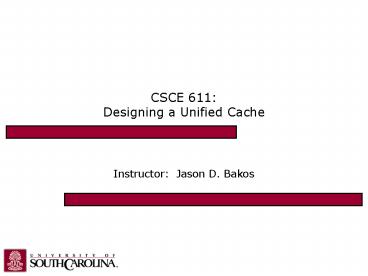CSCE 611: Designing a Unified Cache - PowerPoint PPT Presentation
1 / 10
Title:
CSCE 611: Designing a Unified Cache
Description:
A cache is a memory that stores a subset of the main system memory. It allows for fast access to memory locations that are stored in the cache ... – PowerPoint PPT presentation
Number of Views:35
Avg rating:3.0/5.0
Title: CSCE 611: Designing a Unified Cache
1
CSCE 611Designing a Unified Cache
- Instructor Jason D. Bakos
2
Caches
- A cache is a memory that stores a subset of the
main system memory - It allows for fast access to memory locations
that are stored in the cache - Access to memory locations in the cache are
faster than accesses to main memory - Implemented with SRAM as opposed to DRAM
- Caches are on-chip
- Caches are smaller than main memory
3
Caches
- The cache is part of the memory hierarchy
- CPU memory interface is connected only to the
cache - CPU reads/writes to a location in the cache
- Cache hit
- Can be performed in one clock cycle
- CPU reads/writes to a location not in the cache
- Cache miss
- Cache must delay CPU and retrieve the location
from memory
main memory
cache
CPU
4
Caches
- Caches speed up average memory access time using
two principals - Temporal locality
- The same memory location tends to be accessed
multiple times during the execution of a program - Spatial locality
- Closely addressed memory locations tend to be
accessed together (i.e. arrays and data
structures) - For this reason, the cache is designed as a set
of cache lines, where each line stores multiple
consecutive words
5
Designing Your Cache
- We will design a simple cache with the following
attributes - Direct-mapped
- Each memory address can exist within only one
possible cache line - For any memory access, the cache only needs to
check one cache line to see if the word is in the
cache - If not, the cache line is replaced with a new
cache line that contains the word - This is a cache miss
- Write-back
- When a word is written to the cache, the cache
line is marked as dirty - When a dirty cache line is replaced, the line is
first written to memory
6
Cache Layout
- Here is a 8 line cache, where each line is 4
words
word is indexed by address(32)
line is indexed by address(64)
tag is address(317)
valid
dirty
tag
word0
word1
word2
word3
line
0
1
2
3
4
5
6
7
7
Cache Controller
- Cache hits may be performed combinationally
- Also allow for halfword and byte writes
- The cache controller must
- interface with the memory model
- Use burst reads and writes
- service cache misses
- miss on clean line (replace a cache line, make
CPU wait) - miss on dirty line (write line back to memory,
replace cache line, make CPU wait)
8
Cache Controller Operation
- When the CPU performs a memory access
- If corresponding line isnt valid or tag
mismatches - Raise wait signal
- Request memory bus from arbiter
- If dirty bit is set, burst write the line to
memory, else skip - Burst read the cache line from memory
- Write tag, valid bit, and dirty bit
- Else, if the access is a write, mark dirty bit
for the corresponding cache line
9
Notes
- Design a 1-bit register for valid and dirty bits
- Use 32x1 RAM component in CSELib for tag and
cache data
10
Notes
- 32x1 RAM is 32 individually addressable bits
- Use in parallel to design arbitrary RAM
structures - Use hierarchy to manage design size
- 32x8 RAM
- 32x32 RAM
- Tag size should be based on 24-bit addresses from
MemoryModel - Design a 32 line, 4 word/line direct-mapped
write-back cache and use as a unified cache - Use to run Simpletest
- Due date Friday, April 27
- What to turn in
- Waves from Simpletest simulation
- Cache designs (no generated VHDL)































